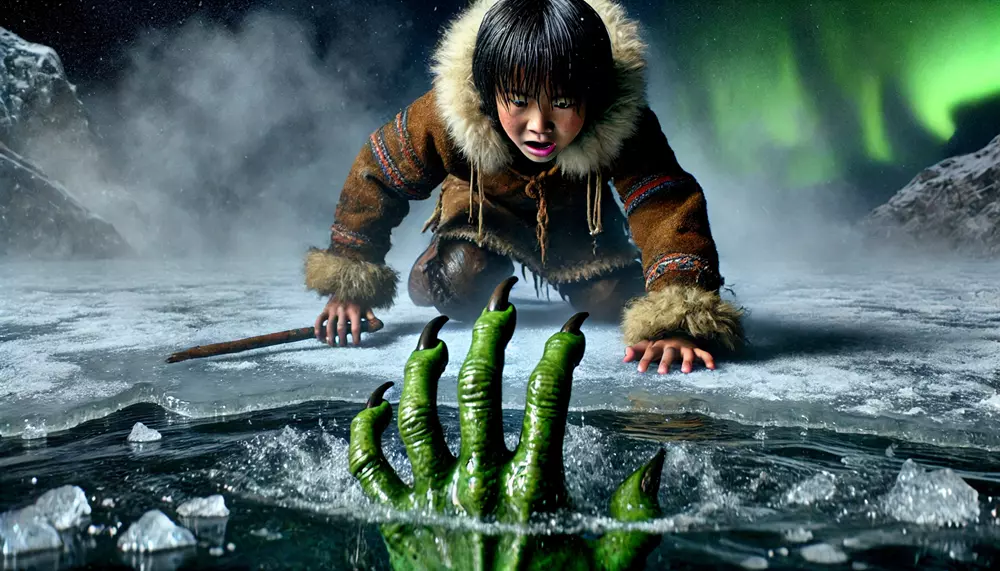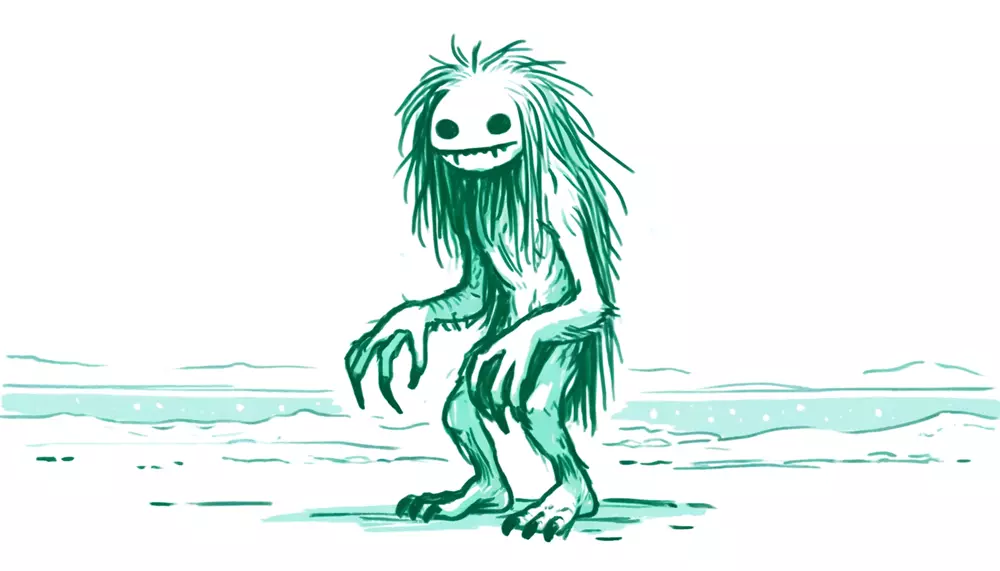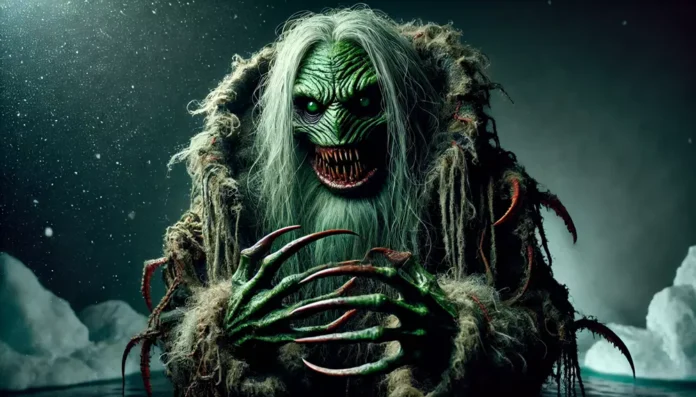Introduction
The Qalupalik is a sinister figure from Inuit folklore, lurking in icy waters, waiting to lure unsuspecting children close. Known for its chilling voice and green-skinned, clawed appearance, this creature has haunted Inuit tales for centuries. Often described as a creature with a pouch to carry children it captures, the Qalupalik embodies the dangers that lie beneath the cold, dark waters of the Arctic. With stories rooted deeply in caution and survival, Qalupalik warns of nature’s hidden threats, drawing on the community’s collective fear of the unknown.
History/Origin
The Qalupalik myth originates from Inuit oral tradition, woven into stories passed down to instill caution in children near icy waters. Dating back to the earliest days of Inuit settlements, the Qalupalik embodied the perils of the Arctic seas, reflecting a world of unpredictable waters and hidden dangers. Inuit communities relied on storytelling to communicate survival lessons, and the Qalupalik became a powerful figure in these narratives. Stories describe it as a creature able to breathe underwater and lure children with a haunting, almost hypnotic call. The Qalupalik’s roots intertwine with other cautionary tales, making it a powerful force in Inuit culture.
In one of the recorded stories, an elder recounts: “The Qalupalik waits below, and her voice drifts like mist over the water. She promises comfort, but only ice and sorrow follow those who heed her.” This haunting quote illustrates how the Qalupalik has become a symbol of nature’s deceptive beauty and underlying danger, cautioning listeners to remain wary.
The Qalupalik legend is not just folklore but a living reminder of the Arctic’s perils, deeply embedded in Inuit life. Many elders continue to tell of its treachery, painting a vivid picture of the creature’s green skin and how its call lures children into the depths.
Name Meaning
The name “Qalupalik” directly translates to “one who has an upturned parka.” In the Inuit language, this phrase emphasizes the creature’s ability to carry children away, using the parka-like pouch to hide them. In some dialects, the term also implies a “hidden threat,” capturing the essence of the Qalupalik’s purpose as a warning symbol in Inuit culture.
Appearance
The Qalupalik appears as a humanoid with green skin, sharp claws, and long, tangled hair floating eerily in the water. Its most distinguishing feature is the upturned parka it wears or appears to wear, which acts as a pouch to carry away those it captures. Some accounts add that the Qalupalik has large, webbed hands, enhancing its aquatic abilities, and an elongated face with hollow eyes that seem to glow. Its skin, often described as slimy and cold to the touch, blends seamlessly with the icy depths, camouflaging the creature from unsuspecting prey.
Background Story
One of the most famous Qalupalik tales tells of a child who ventured too close to the shore, entranced by a strange, melodic voice. The voice promised warmth and safety, lulling the child into a false sense of security. As the child leaned closer, a green hand shot up, pulling them into the frigid waters. Stories like this served as dire warnings, particularly to children, who were most vulnerable to the Qalupalik’s lure. Parents used this tale to instill a healthy fear of the water’s edge, especially during the dangerous seasons when the ice thinned.

Another Inuit elder recounts: “She calls to the lonely and lost, offering them comfort in a cold world, but her embrace brings only silence beneath the waves.” This line captures the paradox of the Qalupalik’s promise versus its deadly reality, a theme that underscores many stories in the Arctic’s oral traditions.
Cultural Impact
The Qalupalik has influenced Inuit cultural practices and beliefs significantly. In Inuit tradition, stories of Qalupalik are part of a broader narrative that emphasizes survival skills and respect for nature. The creature symbolizes the perils of overconfidence and the importance of vigilance in a harsh environment. It has become emblematic of the Arctic’s dual beauty and danger, reminding the Inuit community of the unpredictable nature of their icy world. Qalupalik tales are often told during the long winter nights, fostering a sense of caution among younger listeners.
Beyond cautionary tales, the Qalupalik has also influenced certain rites of passage. For instance, young Inuit are taught to recognize the sounds of safe ice versus dangerous, thin ice, an auditory lesson rooted in Qalupalik’s tales. The stories reinforce life skills necessary for navigating the Arctic terrain, embedding practical wisdom into cultural narratives.
Similar Beasts
The Qalupalik bears similarities to other mythological water beings across different cultures. Like the Slavic Rusalka, who lures humans to watery graves, and Japan’s Kappa, who lurks in rivers waiting to drag children under, the Qalupalik embodies the theme of dangerous waters. The Celtic Kelpie, a shape-shifting water horse, also resonates with the Qalupalik’s warnings, as both creatures serve to caution humans against venturing too close to dangerous waters.

In all these myths, the creatures symbolize nature’s dangers, especially around water, warning listeners of unseen threats lurking beneath the surface. Though culturally distinct, the messages remain consistent: respect and caution around natural forces.
Religion/Ritual
Inuit culture doesn’t have organized religious practices involving the Qalupalik, but it does feature prominently in community stories and informal rites. Elders tell Qalupalik stories to children to instill respect for the water’s edge. While there aren’t formal ceremonies for Qalupalik, it plays an integral role in shaping young minds about survival and caution in their daily lives. Some communities believe whispering the Qalupalik’s name near water could ward off bad spirits, adding a small ritualistic element to its legend.
Scientific or Rational Explanations
The Qalupalik legend likely stems from the dangers of Arctic waters. The icy, dark environment, along with the risk of thin ice, creates a natural hazard for young, curious children. Inuit storytellers may have created the Qalupalik to explain drowning incidents and promote safety among younger members of the community.
Additionally, cold-water immersion can cause hypothermia and shock, leading to quick drowning. The Qalupalik’s “lure” may represent the deceptive nature of the still, frozen landscape, hiding perilous thin spots that could give way underfoot. The myth could also symbolize the fear of isolation in the Arctic, where wandering too close to danger leads to tragic consequences.
Modern Cultural References
The Qalupalik myth continues to captivate modern audiences, inspiring stories, artworks, and media depictions across various platforms. Here are some notable examples:
Literature: The Orphan and the Qallupilluit by Neil Christopher: This children’s book narrates the tale of a young Inuit boy’s encounter with the Qallupilluit, offering readers insight into traditional Inuit stories.
Animation: Nunavut Animation Lab: Qalupalik: This animated short film depicts the story of the Qalupalik, bringing the myth to life through visual storytelling.
Video Games: Never Alone (Kisima Ingitchuna): In this puzzle-platformer game, players encounter the Qalupalik as one of the adversaries, introducing Inuit mythology to a global gaming audience.
Art: Joy Ang’s Illustrations: Commissioned by Inhabit Media, artist Joy Ang has created modern horror interpretations of the Qalupalik, contributing to the creature’s contemporary visual representation.
These instances highlight the Qalupalik’s presence in contemporary media, reflecting its enduring influence from Inuit folklore to modern entertainment and art.
Conclusion
The Qalupalik remains a potent symbol in Inuit folklore, embodying the perils of nature and the importance of respect for the Arctic environment. Its chilling call and eerie appearance have made it a haunting presence in Inuit culture, reminding all who hear its tale of the risks hidden beneath serene waters. The Qalupalik, both a myth and a living lesson, will continue to be retold, ensuring future generations heed its warning: never underestimate the silent threats lurking in the world around us.









